Thank you for visiting! By the way… any links on this page that lead to products on Amazon and other stores/partners are affiliate links Aquarium Store Depot earns a commission if you make a purchase.
Are you new to reef tanks? Thinking of setting one up and don’t know where to start when it comes to choosing fish? Well, you’ve come to the right place! In this article, we’re going to take a look at 10 saltwater fish that are perfect for beginners – and 3 that you should avoid at all costs. By the time you’re done reading, you’ll be armed with all the information you need to make the right choices for your tank. So let’s get started!
Saltwater For Beginners
Before considering which fish to get for your new saltwater aquarium, make a checklist and be prepared as best as possible for beginner mistakes and errors.
The saltwater hobby is said to be more difficult than the freshwater side. This is true to some extent–and saltwater is definitely much more expensive–but if done right, it doesn’t have to be a challenge. Instead, make sure that your tank is fully set up and ready to accommodate an ecosystem:
- Allow the tank to fully cycle.
- Compile a stocking list with respect to space and aggression.
- Add beginner saltwater fish slowly and test water parameters regularly.
- Continue regular tank maintenance.
Keep in mind that cycling a saltwater aquarium can take anywhere from 4 to 6 weeks and cannot be rushed. Also, remember that saltwater fish require much more space than freshwater ones, which can greatly impact the vision you originally had for your tank.
But how hard are saltwater fish for beginners and how can you make sure you’re stocking your tank correctly?
How Hard Is It To Keep This Type for a Pet?
The truth is that many popular saltwater fish are incredibly hardy and forgiving of beginner mistakes. Popular species, like damselfish, are some of the hardiest fish available and can make the transition from freshwater to saltwater seamless.
Saltwater tanks aren’t difficult to keep and beginner saltwater fish adapt quickly. The most challenging aspect of keeping a marine ecosystem is balancing parameters, regulating algae, and not getting discouraged when things go wrong.
The new parameter relevant to saltwater is salinity, which needs to remain around 1.020-1.025. Saltwater aquariums evaporate very quickly, especially if rimless. Unlike freshwater that can easily be topped off, evaporation causes salinity to increase. This requires some calculations as to how much freshwater needs to be added in order to maintain a constant salinity. An auto top off system and help take the guess work away.
Algae can also be much more difficult to remove in the saltwater aquarium. Various aspects, like marine salt mix, source water, and lighting, can all affect how phosphates and nitrates enter the system and subsequently influence algae growth. It will take a few months for a new tank to move past its ugly stage and even longer for hobbyists to understand how nutrients are moving through their systems.
Lastly, and probably the most challenging step, is to not get discouraged. Saltwater is expensive and losing a fish hurts. Hobbyists quickly learn to use a quarantine system to their advantage and have various medications on hand for immediate response.
It is also very common to experience a complete tank crash at least once. This can be due to malfunctioning equipment, power outages, aggressive fish, marine fish diseases, or even invertebrates that expel toxins into the water column overnight. Sadly, there is no absolute way to prevent a crash, though you will get better at damage control.
It will take some time to understand how to regulate and correct mistakes and irregularities in your system. Once your fish are established though, the payoff definitely becomes worth it.
Is This Species High Maintenance?
Saltwater fish tanks can be high maintenance, but routine makes it easy.
In the beginning stages of your tank, you may need to perform more regular water changes and test water parameters more often. During this time, the tank is becoming established, growing beneficial bacteria and balancing with the added bioload of new fish and invertebrates.
Once the tank has matured and all livestock has been added, then maintenance becomes routine. Most hobbyists only need to spend an hour or two with their tanks every week for weekly or biweekly water changes and freshwater top-offs.
It should be noted that this time range can change dramatically depending on the size and stocking of the system. A small polyp stony (SPS) coral-dominant tank will require much more trial and error and general maintenance than a basic fish only (FO) setup.
How much time you’re willing to put in will have direct effects on the appearance and health of the ecosystem. That being said, you might be wondering which size tanks take the least time but offer the biggest reward. Again, this will largely depend on the budget allowed and the type of system desired.
What Is The Best Tank Size For Newbies?
In general, a 40 gallon breeder or 60 gallon breeder tank (which replaced the 55 gallon tank) are recommended as the best tanks for beginners. Both of these tanks are standard in size, keeping equipment relatively inexpensive and easy to find. These sizes also have decent water volume, which can make fluctuations and imperfections in water parameters easier to manage. Lastly, they don’t take up too much space but can still hold a decent amount of livestock.
This new 60 gallon breeder by Aqueon has the length and width of a 75 gallon tank, but at a shorter height. This is the most economical and effective 4 foot gallon tank for the saltwater hobby now.
While these are the recommended sizes, both larger and smaller setups are completely in reach of beginner’s capabilities. Larger setups generally require a larger budget and more equipment but allow for much more life. Smaller setups need more consistency through testing and maintenance and don’t allow as much biodiversity, but are much less expensive and more compact.
10 Best Winners
Though saltwater aquarium fish are easier than they might seem, there are some species that are considerably easier than others and more suited for beginners. Below is our YouTube video from our channel if you want a visual. We’ll go into further detail below in the blog.
Don’t be fooled, though! This doesn’t make these fish any less beautiful and many are staples for the home aquarium.
1. Clownfish
Best Choice For Reef Tanks!
Clownfish are hardy, full of personality, and are safe for all corals. They are an icon for any saltwater tank
- Genera: Amphiprion and Premnas
- Size: 3-6 inches
- Origin: Indo-Pacific
- Tank Size: 20 gallons
- Available As Tank Bred: Available
Clownfish are one of the most recognizable saltwater aquarium fish available. But did you know that there are about 30 different species of this orange and white striped marine fish with even more variations available?
The ocellaris clownfish (Amphiprion ocellaris), also known as the false percula clown, is the most common species to come across and is an ideal tank mate for smaller community tanks. More aggressive types and larger clownfish, like the maroon clownfish (Premnas biaculeatus), can easily fit into bigger reefs and more involved ecosystems.
2. Royal Gramma
The Royal Gramma is a great looking fish with personality. Reef safe and will get along with most fish.
- Species Type: Gramma
- Scientific Name: Gramma loreto
- Size: 3 inches
- Origin: Western Central Atlantic Ocean
- Tank Size: 30 gallons
- Available As Tank Bred: Rare
The royal gramma is another popular addition to the saltwater aquarium. This half-yellow and purple fish is appealing for beginner hobbyists due to its small size and bright colors.
Though colorful and inexpensive, these beginner saltwater fish can become aggressive towards other fish in the aquarium, especially similar-looking species that were added afterward. Royal gramma are extremely hardy fish and definitely have a lot of character to bring to the home saltwater aquarium, but aggression will need to be monitored as the fish becomes more confident in its environment.
3. Bangaii Cardinalfish
Peaceful great in pairs, these cardinalfish are great tankmates, hardy, and breed in saltwater tanks. Completely reef safe.
- Species Type: Pterapogon
- Scientific Name: Pterapogon kauderni
- Size: 3 inches
- Origin: Banggai Islands, Indonesia
- Tank Size: 30 gallons
- Available As Tank Bred: Available
Bangaii cardinalfish, or Kaudern’s cardinalfish, are a little more desirable than the related pajama cardinal (Sphaeramia nematoptera). These small, black and white mouthbrooding fish have also been known to successfully breed in the aquarium, making them a fun challenge for more experienced hobbyists.
Bangaii cardinalfish are only native to the Banggai Islands in Indonesia and some surrounding islands, making them a rare fish to come across in the wild. As a result, most of the Bangaii cardinalfish available in the aquarium hobby have been aquacultured.
4. Chalk Bass

- Species Type: Serranus
- Scientific Name: Serranus tortugarum
- Size: 3 inches
- Origin: Western Atlantic Ocean
- Tank Size: 30 gallons
- Available As Tank Bred: Available
If you’re looking for a marine fish that isn’t commonly found in beginner aquariums, then the chalk bass might be right for you. These fish are relatively plain in color, with a bluish-white base coat and overlaying red stripes at the top of their dorsal.
Chalk bass are very hardy and fit perfectly into the community reef tank. In fact, these beginner saltwater fish are commonly kept together in small groups, though they might not always exhibit schooling behaviors. They can be shy at first but will swim in the open given the correct conditions.
5. Yellow Coris Wrasse
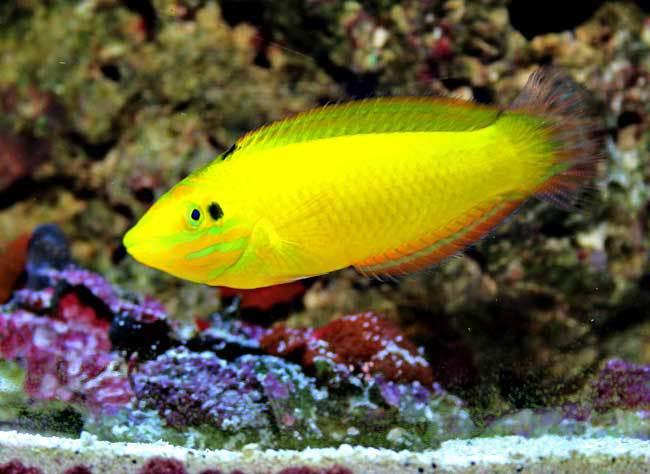
- Species Type: Halichoere
- Scientific Name: Halichoeres chrysus
- Size: 5 inches
- Origin: Eastern Indian Ocean
- Tank Size: 50 gallons
- Available As Tank Bred: Rare
The yellow coris wrasse is bright yellow and difficult to pass over when shopping for new saltwater aquarium fish. Due to the size and activity of this beginner saltwater fish, yellow coris wrasses need more space than the other fish on this list.
These fish are one of the hardiest species of wrasse and like to be around other wrasses. They won’t touch corals in a reef tank, but they are likely to eat other small invertebrates available in and around the rock.
6. Tank Raised Coral Beauty Angelfish
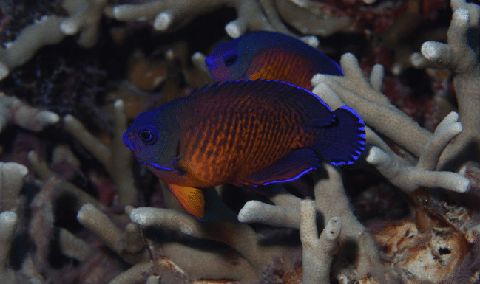
- Species Type: Centropyge
- Scientific Name: Centropyge bispinosa
- Size: 4 inches
- Origin: Indo-Pacific Ocean
- Tank Size: 70 gallons
- Available As Tank Bred: Available
For a long time, coral beauty angelfish were shoved into nano tanks. Just recently, hobbyists have started appreciating them as the fish that they are and housing them in the large tank setups they deserve. Though relatively small, coral beauties need room to swim and algae to graze on.
Coral beauty angelfish are relatively peaceful, but have been known to be aggressive towards similar species, like the flame angelfish (Centropyge loricula). It is believed that coral beauties are more reef-safe than their flame counterparts, but it is still possible for them to nip at corals. They are available as tank bred now. These tank bred varieties are hardier and establish better in home aquariums than their wild caught counterparts.
7. Azure Damselfish
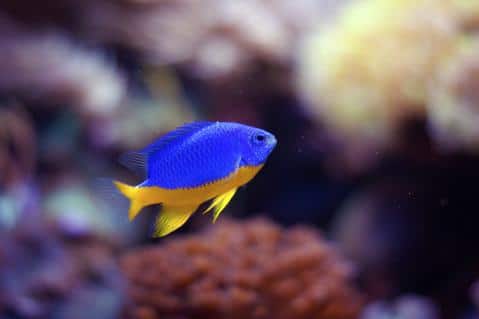
- Species Type: Chrysiptera
- Scientific Name: Chrysiptera hemicyanea
- Size: 3 inches
- Origin: Indo-Pacific Ocean
- Tank Size: 30 gallons
- Available As Tank Bred: Available
In addition to clownfish, other species of damselfish are very popular saltwater fish for beginners. However, they’re not always the best choice.
In general, damselfish are very aggressive fish; though cheap and small, beginners often make the mistake of adding these beginner saltwater fish to their aquariums and having other fish be terrorized by them.
Luckily, the azure damsel is one of the least aggressive species of damselfish though there’s still the possibility that they’ll establish strict territories and attack tank mates.
8. Yellow Watchman Goby

- Species Type: Cryptocentrus
- Scientific Name: Cryptocentrus cinctus
- Size: 4 inches
- Origin: Western Pacific Ocean
- Tank Size: 20 gallons
- Available As Tank Bred: Available
The yellow watchman goby is a very fun fish to have, especially if you pair it with a symbiotic species of pistol shrimp, like the tiger pistol shrimp (Alpheus bellulus); this pairing is especially popular in nano setups. Otherwise, these beginner saltwater fish are bright yellow and can bring activity to the bottom of any tank.
Yellow watchman gobies can be timid fish at first. They will burrow into the substrate and underneath rock to form tunnels, which can help be maintained by a pistol shrimp. Though these gobies won’t stray far from their burrows, they’ll come out for food and constantly try to make their home better.
9. Tank Raised Yellow Tang
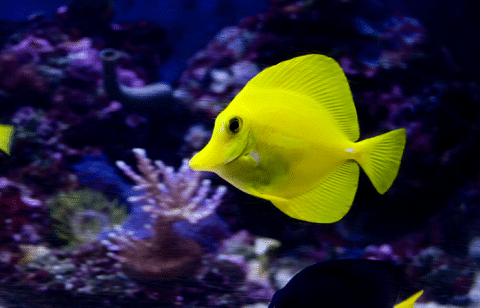
- Species Type: Zebrasoma
- Scientific Name: Zebrasoma flavescens
- Size: 8 inches
- Origin: Pacific Ocean
- Tank Size: 125 gallons
- Available As Tank Bred: Available
Yes, yellow tangs can be a great beginner saltwater fish given that conditions are right. Hobbyists interested in getting a yellow tang for their tank need to understand that these fish are active swimmers and active grazers; they need a lot of open swimming space but they also need a lot of rock to pick at algae and other microflora.
Many yellow tangs originated from Hawaii. Unfortunately, these ecosystems have been affected by overharvesting and Hawaii’s Department of Land and Natural Resources has needed to intervene. In early 2021, harvesting permits could not be renewed and all current permits became invalid.
Luckily, the yellow tang is commonly bred in captivity so that their delicate Hawaiin ecosystems can be repaired. This tank bred yellow tangs are hardy and adapt easily to aquarium life.
10. Firefish Goby
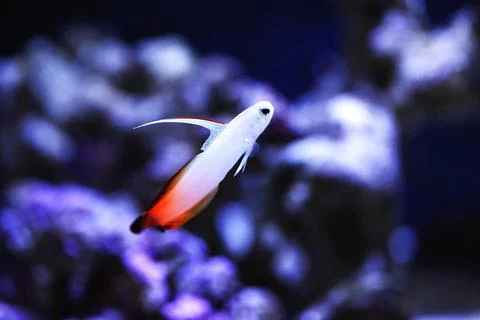
- Species Type: Nemateleotris
- Scientific Name: Nemateleotris magnifica
- Size: 3 inches
- Origin: Indo-Pacific Ocean
- Tank Size: 10 gallons
- Available As Tank Bred: Available
Firefish goby are cheap, small, and unique looking, but they can quickly disappear from a saltwater tank. Unfortunately, these fish have a bad habit of jumping out of aquariums or disappearing behind rocks. This can dissuade some hobbyists, thinking they’ve done something wrong to kill the fish when actually these fish are just notorious for being difficult!
If you’re looking for something a little more colorful but with the same personality as the firefish, then a purple firefish (Nemateleotris decora) might be what you’re looking for! Make sure to use a tight-fitting lid.
Top 3 Types To Avoid
Before going out and picking up a fish for your new aquarium, there are some saltwater fish species you should actively try to avoid. Here’s another video by yours truly. I’ll provide details below in the blog post.
Though saltwater isn’t much more difficult than freshwater in the basic sense, there are some saltwater fish you will want to avoid as a beginner. Some other fish species can be sensitive to water parameters, prone to illness, or demanding when it comes to tank size and diet. These fish require extra time, consideration, and budget.
1. Hippo Tang (Blue Tang AKA Dory)
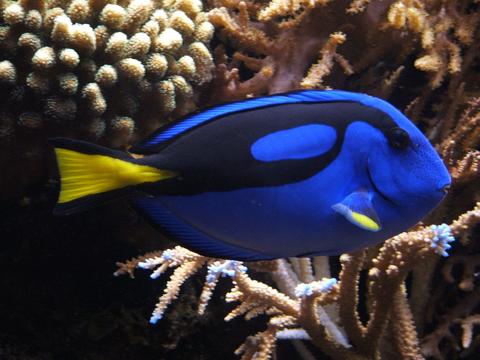
- Species Type: Paracanthurus
- Scientific Name: Paracanthurus hepatus
- Size: 12 inches
- Origin: Indo-Pacific Ocean
- Tank Size: 180 gallons
- Available As Tank Bred: Available
The hippo tang goes by a few names including blue tang, hepatus tang, regal tang, and Dory fish. The fame from the movie has made this a very popular saltwater aquarium fish. Unfortunately, they are rarely kept in the conditions they need to thrive, though.
The hippo tang is not the best beginner saltwater fish due to its size, high activity levels, and sensitivity to water parameters and diseases. These fish are sold while they are only a few inches long, making them seem attainable by the average hobbyist. Within a year, they can grow to be several inches, causing many unaware hobbyists to have to find new homes for their tang.
2. Mandarin Goby
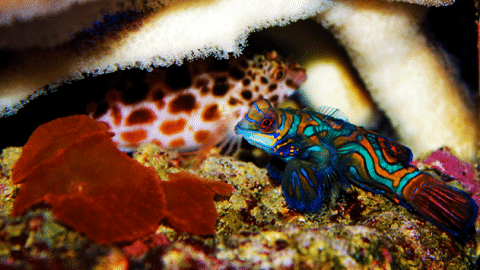
- Species Type: Synchiropus
- Scientific Name: Synchiropus splendidus
- Size: 3 inches
- Origin: Western Pacific Ocean
- Tank Size: 30 gallons
- Available As Tank Bred: Rare
Mandarin gobies are probably the most beautiful saltwater fish available but are actually one of the worst fish to have for anyone lacking experience.
These fish need a constant supply of copepods and other small invertebrates. Not only does this mean that the tank should naturally be mature with a stable ecosystem, but it may also involve setting up another system just to harvest food. Even then, these fish have been known to reject food and starve.
3. Copperband Butterflyfish
- Species Type: Chelmon
- Scientific Name: Chelmon rostratus
- Size: 8 inches
- Origin: Indo-Pacific Ocean
- Tank Size: 125 gallons
- Available As Tank Bred: Rare
The copper band butterflyfish is another beautiful yet difficult-to-keep saltwater fish. Like mandarin gobies, copperband butterflies rely heavily on live rock and supplemental feedings for their invertebrate-based diet. In addition, the copperband butterfly can grow to be relatively large and is an active swimmer.
These fish also fail to thrive when there are other larger, more active fish in the reef aquarium so some stocking consideration is needed. If you want to see how a healthy establish copper band butterfly behaves, check out Aaron’s video above. They need a well-established reef aquarium to thrive.
FAQs
What Is The Most Peaceful Types?
If you’re looking to set up a community reef tank, then you’ll want fish that are fully compatible with each other. This is definitely more difficult in the saltwater setting than for a freshwater aquarium, but there are still many options available.
Many of the species on our list of the best saltwater fish for beginners are compatible with one another. This extends to other species of tang, goby, blenny, butterflyfish, and angelfish. For the most part, these fish will happily live alongside one another; it should be noted that some species cannot be kept with similar-looking species, so caution is needed.
What Is The Most Aggressive?
Instead of the traditional reef tank, some saltwater hobbyists choose to set up a predatory tank. These can be popular among beginner hobbyists who are more attracted to statement fish, like pufferfish and triggerfish.
It can be difficult to tell which saltwater fish are aggressive, though. Of course, the ones with noticeable spikes or protruding teeth should be avoided if planning on setting up a community tank. However, some damselfish can be even more aggressive than predatory fish and every individual fish will have its own personality and behavior in the tank.
Because of this, it’s important to have a back up plan if suddenly one of your peaceful fish becomes aggressive overnight–yes, this does happen! This might include being able to return the fish to a local pet store or rehoming it to another hobbyist.
What Is The Easiest Type To Keep?
Tank raised clownfish are the overall easiest saltwater fish to keep in the trade. There are many varieties available and they are tolerate of many beginner mistakes. For smaller tanks, tank raised gobies can be a good option.
Are They High Maintenance?
No, saltwater fish are not high maintenance if you select the right ones. However, there are more factors to consider with saltwater fish than with freshwater fish. Marine fish require more water prep, and more expensive equipment, and diseases are more prevalent. All these factors make them more difficult to keep than most freshwater fish.
Final Thoughts
The world of saltwater can be scary, but also incredibly exciting! There are tons of popular fish species to pick from and the options might seem limitless.
If you’re just starting out though, there are definitely some beginner saltwater fish that are easier to keep than others. Once you feel confident in keeping those, then you can move on to the more challenging and expensive species.
Until then, maintain your water parameters and make your fish as happy as they can be!
- About the Author
- Latest Posts
I’m thrilled that you found Aquarium Store Depot! Here you’ll find information on fish, aquariums, and all things aquatics related. I’m a hobbyist (being doing this since I was 11) and here to help other hobbyists thrive with their aquariums! I adhere to a high quality Editorial Process and Review products with real life field usage and practical analysis.


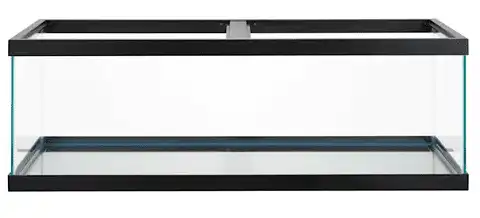
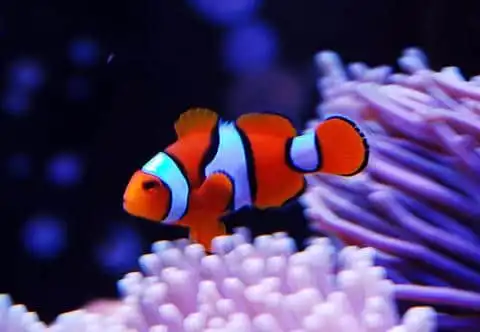

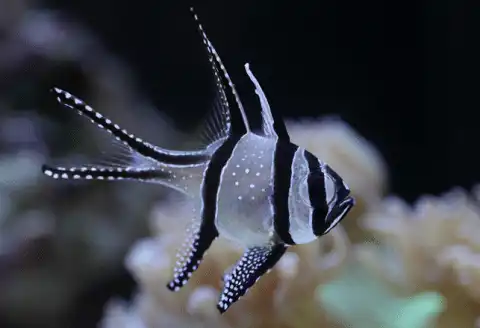




very impormative..almost all that you say is true..i have learned a lot..merci..
Thank you Relly for your comment 🙂